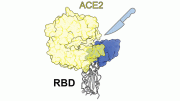Advanced X-ray techniques yield insights into a bacterial enzyme that turns methane gas into liquid fuel.
Scientists have determined the structure of a unique enzyme, produced by a species of methane-eating bacteria, that converts the greenhouse gas into methanol – a highly versatile liquid fuel and industrial product ingredient.
Their new study, published in the Journal of the American Chemical Society, is the first to report the structure of the enzyme, called soluble methane monooxygenase (sMMO), at room temperature in both its reduced and oxidized forms. This detailed structural information will help researchers design efficient catalysts for industrial methane to methanol conversion processes.
“We were able to reveal the structure of sMMO and see how the environment of the two iron atoms in the enzyme’s active site changes and supports the catalysis of this challenging chemical reaction,” said author Jan Kern, a Berkeley Lab bioscientist. The process “involves breaking a carbon-hydrogen bond and insertion of an oxygen – converting a hydrocarbon into an alcohol. Additionally, our results showed the value of using an X-ray free electron laser (XFEL) in situations where traditional crystallography is not possible, in this case due to the reactive metals within the center of the enzyme.”
Studying such enzymes by traditional X-ray methods typically gives incorrect results because of radiation damage. By using XFEL, the researchers were able to get accurate structural information in the two oxidation states.
Bacteria that metabolize methane (methanotrophs) are found in soil and aquatic environments with little to no oxygen. In these anaerobic habitats, the bacteria play a critical role as carbon recyclers; they convert methane (CH4) into more useful molecules that they and other organisms depend on.
Reference: “High-Resolution XFEL Structure of the Soluble Methane Monooxygenase Hydroxylase Complex with its Regulatory Component at Ambient Temperature in Two Oxidation States” by Vivek Srinivas, Rahul Banerjee, Hugo Lebrette, Jason C. Jones, Oskar Aurelius, In-Sik Kim, Cindy C. Pham, Sheraz Gul, Kyle D. Sutherlin, Asmit Bhowmick, Juliane John, Esra Bozkurt, Thomas Fransson, Pierre Aller, Agata Butryn, Isabel Bogacz, Philipp Simon, Stephen Keable, Alexander Britz, Kensuke Tono, Kyung Sook Kim, Sang-Youn Park, Sang Jae Lee, Jaehyun Park, Roberto Alonso-Mori, Franklin D. Fuller, Alexander Batyuk, Aaron S. Brewster, Uwe Bergmann, Nicholas K. Sauter, Allen M. Orville, Vittal K. Yachandra, Junko Yano, John D. Lipscomb, Jan Kern and Martin Högbom, 20 July 2020, Journal of the American Chemical Society.
DOI: 10.1021/jacs.0c05613
This research was a collaboration between scientists at Berkeley Lab, University of Minnesota, Stockholm University, SLAC, and the Diamond Light Source.










Be the first to comment on "How to Reduce Greenhouse Gas? Tips From Methane-Eating Microbes"